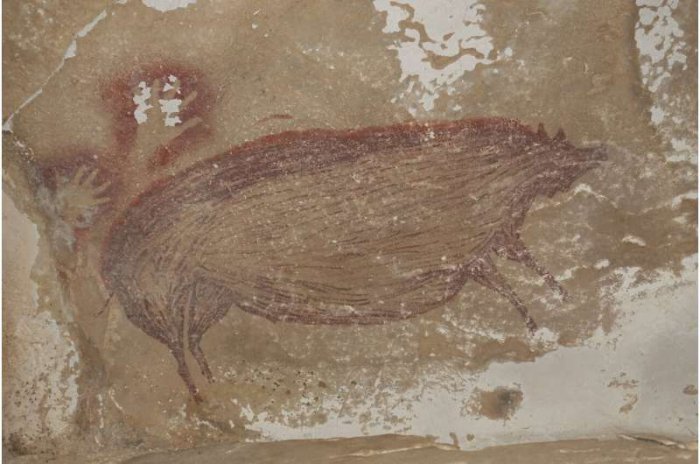Jan Bartek – AncientPages.com – What appears to be the world’s oldest cave painting has been discovered at Leang Tedongnge cave, located in a remote valley in Indonesia.
The cave painting is a life-sized picture of a wild pig and it estimated the drawing was made 45,500 years ago, but it could be much older.
Scientists think the artwork was made by Homo sapiens, as opposed to now extinct human species like Denisovans, but cannot say this for certain.
This finding provides the earliest evidence of human settlement of the region.

Dated pig painting at Leang Tedongnge. Maxime Aubert Credit: Maxime Aubert
“Measuring 136 by 54 centimeters (53 by 21 inches) the Sulawesi warty pig was painted using dark red ochre pigment and has a short crest of upright hair, as well as a pair of horn-like facial warts characteristic of adult males of the species.
There are two hand prints above the pig’s hindquarters, and it appears to be facing two other pigs that are only partially preserved, as part of a narrative scene,” the Agence France-Presse reports.
According to Adam Brumm, co-author of the study published in the journal Science Advances, “the pig appears to be observing a fight or social interaction between two other warty pigs.”
“The people who made it were fully modern, they were just like us, they had all of the capacity and the tools to do any painting that they liked,” Maxime Aubert of Australia’s Griffith University told AFP.
The previously oldest dated rock art painting was found by the same team in Sulawesi. It depicted a group of part-human, part-animal figures hunting mammals, and was found to be at least 43,900 years old.
See also: More Archaeology News
Cave paintings such as these also help fill in gaps about our understanding of early human migrations.
It’s known that people reached Australia 65,000 years ago, but they would probably have had to cross the islands of Indonesia, known as “Wallacea.”
This site now represents the oldest evidence of humans in Wallacea, but it’s hoped further research will help show people were in the region much earlier, which would resolve the Australia settlement puzzle.
Written by Jan Bartek – AncientPages.com Staff Writer





